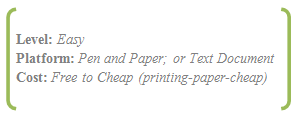As a college student you are going to be taking notes. Whether you’re headed to a student organization meeting, a university lecture, a business meeting, or a public speaker’s presentation on campus, taking effective notes is a critical skill that moves your projects, your career, and your education forward.
Method 1: Split Your Page into Quadrants
One way to take better notes is by splitting your page into quadrants or sections, and recording different kinds of information in each one. According to Adam Pash (2011), Rumor has it that this is how Bill Gates (someone known for taking amazingly detailed and accurate notes) gets it done.
The Cornell note-taking method, discussed here, was tailored especially for students. The purpose of this system is to get your notes right the first time, and to keep them both as thorough, succinct and organized as possible without recopying them later. To use this method, separate the page into different areas, as shown in the picture below (see the links at end of post, they provide the layout so you can print these custom-made pages for taking notes on).
You can use the page as follows (or adjust it to your own liking):
- Note-taking area: Here you can record the lecture, discussion, or meeting as completely as possible using brief sentences in paragraphs. This is where you will lay out the meat of the information. Capture general ideas, and as the instructor moves on to a new point, skip a couple lines to begin a new paragraph.
- Cue Column: Here is where you jot questions and one-liners that connect main ideas in your notes. Later, during a study or review session, you can also cover up the right side of the page and use the left column’s cues to help you recall facts, important concepts or definitions, and overarching themes of the course. Extended information on these jottings should be in the Note-Taking Area. If you weren’t able to write down all the information or definitions discussed in class (which is likely), refer to your Cue Column afterwards, and fill in the gaps in the Note-Taking Area.
It can help to keep the Cue Column and Note-taking area in sync – meaning that jottings in Cue Column align with the related notes in the Note-Taking Area. This isn’t always necessary or practical, but can greatly help. For some ideas on the types of things that can go in the Cue Colum, click here for a more detailed outline with some examples.
- Summary: After the class or meeting is over, write a sentence or two at the bottom of the page summarizing the content of your page of notes, and the discussion or lecture that had taken place. This is a good way to help you build an understanding of the overarching theme of the course you are taking throughout the quarter, as you continue to summarize the most important underlying theme for each day.
- Labeling: In order to keep your notes organized, and to easily find what you're looking for, put Labels at the top of each one. Put the Date and the Topic of the day’s lecture in the Top Right corner. Further, if there were assigned readings for this day, you might want to add what those were in the Top or Bottom Right corner as well – this will make it even easier to reference material you need without looking in multiple places for it.
Links – Print Custom Note Paper
Here are a few free web applications that produce custom PDFs of formatted, lined note paper. Choose one that seems most effective for you and your style of thinking, and print off several copies before your next class. Either put them in a designated folder for your class, or put them in your notes binder (most of these sites provide punch-out holes if you want them). Play around with a few if you can’t find one that works.
- The Cornell Method PDF Generator (Method 2):
For a simpler version with less options go here: http://eleven21.com/notetaker/
For a more detailed generator go here: http://incompetech.com/graphpaper/cornelllined/
- Notes on Readings or Research Articles: http://bit.ly/nw1AdO
Print this PDF layout for a ready-made note-taking outline on your readings or research articles. Maybe you’re working on a research project – this will help you to organize your thoughts and easily refer to the many articles you’ve read and the ways in which they connect to either your research or the overarching theme of the course.
Discussion:
Do you have your own note-taking methods that you use and have found helpful? Share your thoughts and experiences below with others, or pose any questions you may have.



